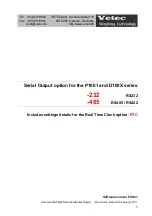
Page 4 of 21
Tel.: (+45) 9614 9614
•
Fax: (+45) 9614 9615
•
E-mail: [email protected]
Display/reading
The unit measures the two inputs voltages: Generator (GEN) and busbar (BB),
respectively. The phase difference from GEN’s zero-crossing to BB’s zero-crossing is
calculated by the processor and is shown on the LED circle, consisting of 36 red LEDs.
The red LEDs are only lit one at a time and its position indicates the phase difference
between GEN and BB. The lit LED simulates the pointer tip of an analogue pointer
instrument. If the LED is lit in the 12 o’clock position, the phase difference is 0
degrees. In the 6 o’clock position, 180 degrees etc. With 36 LEDs the resolution is 10
degrees.
The movement of the lit LED’s position indicates the frequency difference between
GEN and BB. If the indication is turning clockwise (too fast), the GEN frequency is too
high in proportion to the BB frequency. If the indication is turning counter-clockwise,
the proportion is inversed. The rate of the motion tells about the frequency difference.
The faster the rotation, the bigger the frequency difference, e.g. 1 rotation per second
= 1Hz. If the BB frequency is 50Hz and the rotation turns right, the GEN frequency will
be 51Hz in this example.
If the frequency difference between GEN and BB is becoming too big (>3Hz), the
circular motion stops and a LED will be lit at the ‘too fast’ or ‘too slow’ mark, dependent
on which direction the GEN frequency has to be adjusted to.
Normal synchronising
The unit automatically calculates the synchronising parameters to check if there is the
required space for the synchronising inside the preset phase window. These
calculations compare the frequency difference with t
R
and the size of the phase
window. When t
R
is set to
∞
, t
d
can be set by the user and is then included in the
calculations instead of t
R
.
If the
∆ϕ
window is set symmetrically, both underfrequency synchronising and over-
frequency synchronising is possible.
Under- or overfrequency synchronising
When the
∆ϕ
window is set asymmetrically the following functionality is possible:
If the
∆ϕ
window is set asymmetrically with a higher positive than negative
∆ϕ
value, only synchronising with the generator input at lower frequency than the
busbar input is possible (underfrequency synchronising).
If the
∆ϕ
window is set asymmetrically with a lower positive than negative
∆ϕ
value, only synchronising with the generator input at higher frequency than the
busbar input is possible (overfrequency synchronising).
Note:
This function is not active with t
R
set to
∞
.





































